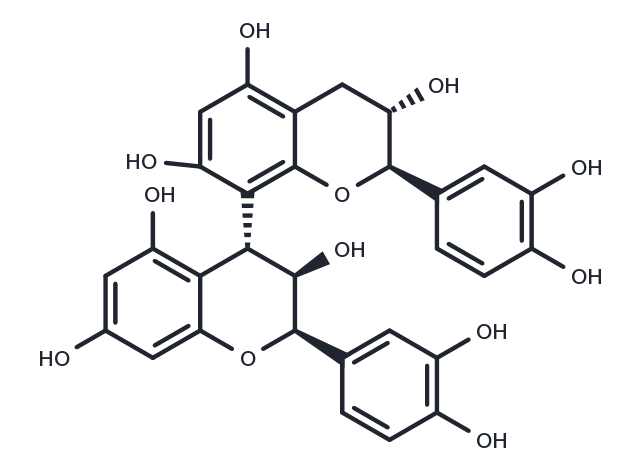Powder: -20°C for 3 years | In solvent: -80°C for 1 year


Procyanidin B1, isolated from commonly eaten fruits, binds to the TLR4/MD-2 complex and has anti-inflammatory activity.

| Pack Size | Availability | Price/USD | Quantity |
|---|---|---|---|
| 1 mg | In stock | $ 47.00 | |
| 5 mg | In stock | $ 178.00 | |
| 10 mg | In stock | $ 289.00 | |
| 25 mg | In stock | $ 489.00 | |
| 50 mg | In stock | $ 686.00 | |
| 100 mg | In stock | $ 969.00 | |
| 1 mL * 10 mM (in DMSO) | In stock | $ 233.00 |



| Description | Procyanidin B1, isolated from commonly eaten fruits, binds to the TLR4/MD-2 complex and has anti-inflammatory activity. |
| In vitro | Procyanidin B1 (100 μg/mL) inhibits LPS-induced TNF-α production, and expression of MD-2, TRAF6, NF-κB mRNA, phosphorylated p38 MAPK and NF-κB protein in THP1 cells [1]. Procyanidin B1 (50-100 μM) protects against Aβ oligomer-induced neuronal death. Procyanidin B1 potently inhibits the activation of caspase-3 at 100 μM, caspase-8 at concentrations of 30, 50, and 100 μM and caspase-9 at concentrations of 10, 30, 50, and 100 μM [2]. Procyanidin B1 (10, 20, 30 μM) significantly and dose-dependently induces expression of ACO and CPT1, with no obvious effect on mRNA expression of PPARα [3]. |
| Cell Research | To investigate the cytotoxic effect of Procyanidin B1, the viability of THP1 cells is assessed using the CCK8 assay. THP1 cells are treated with Procyanidin B1 for 18 h, and 10 μL of CCK8 solution is then added to each well and the cultures are incubated for 4 h at 37°C. The optical density (OD) at 450 nm is measured using an ELx808 Absorbance Microplate Reader. The Procyanidin B1 concentration tested ranges from 50 to 200 μg/mL. Each sample is tested in triplicate [1]. |
| Source |
| Molecular Weight | 578.52 |
| Formula | C30H26O12 |
| CAS No. | 20315-25-7 |
Powder: -20°C for 3 years | In solvent: -80°C for 1 year
DMSO: 23 mg/mL (39.76 mM), Sonication is recommended.
You can also refer to dose conversion for different animals. More
bottom
Please see Inhibitor Handling Instructions for more frequently ask questions. Topics include: how to prepare stock solutions, how to store products, and cautions on cell-based assays & animal experiments, etc.
Procyanidin B1 20315-25-7 Immunology/Inflammation TLR Toll-like Receptor (TLR) Inhibitor Procyanidin B-1 inhibit Procyanidin B 1 inhibitor
